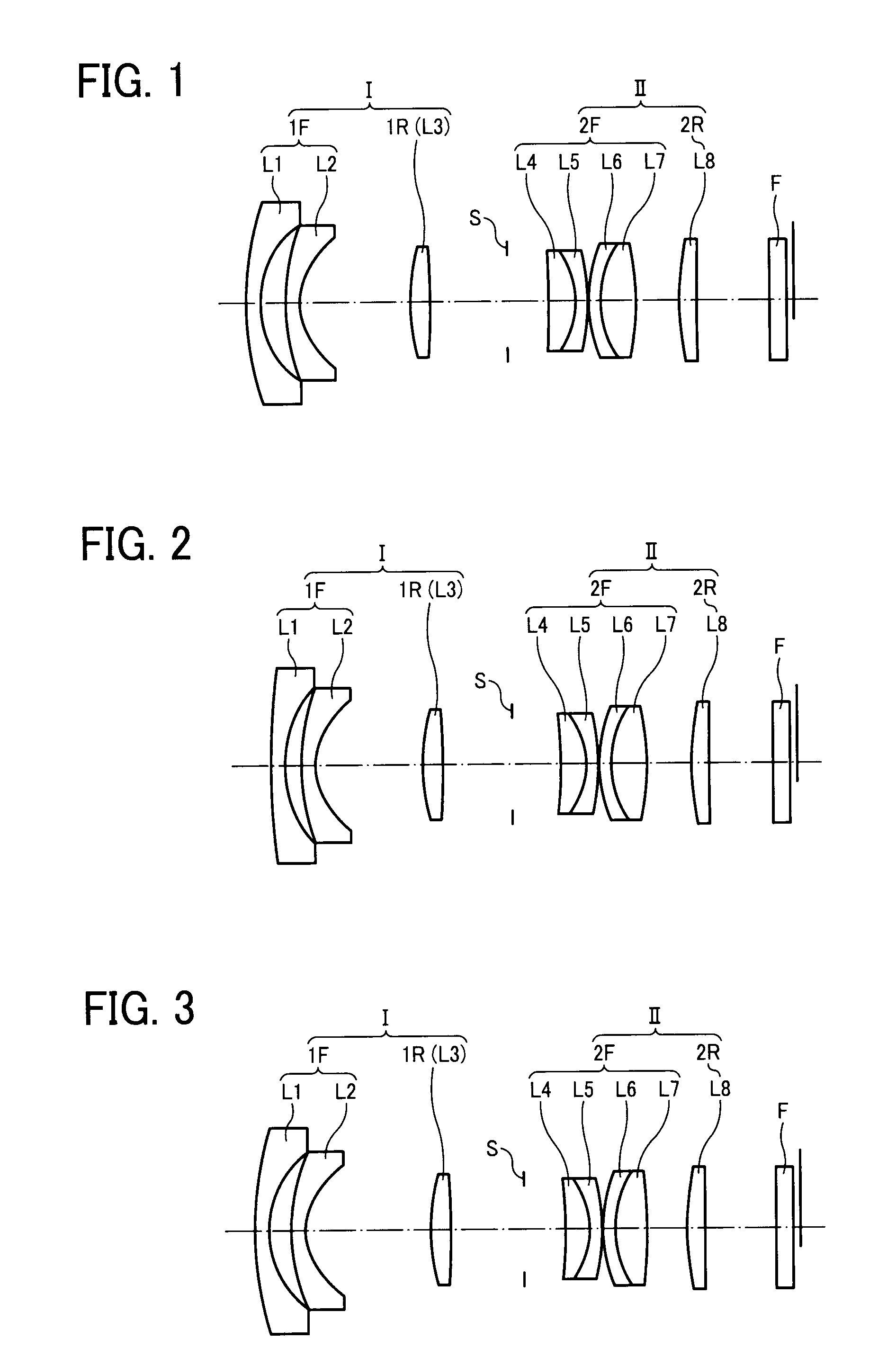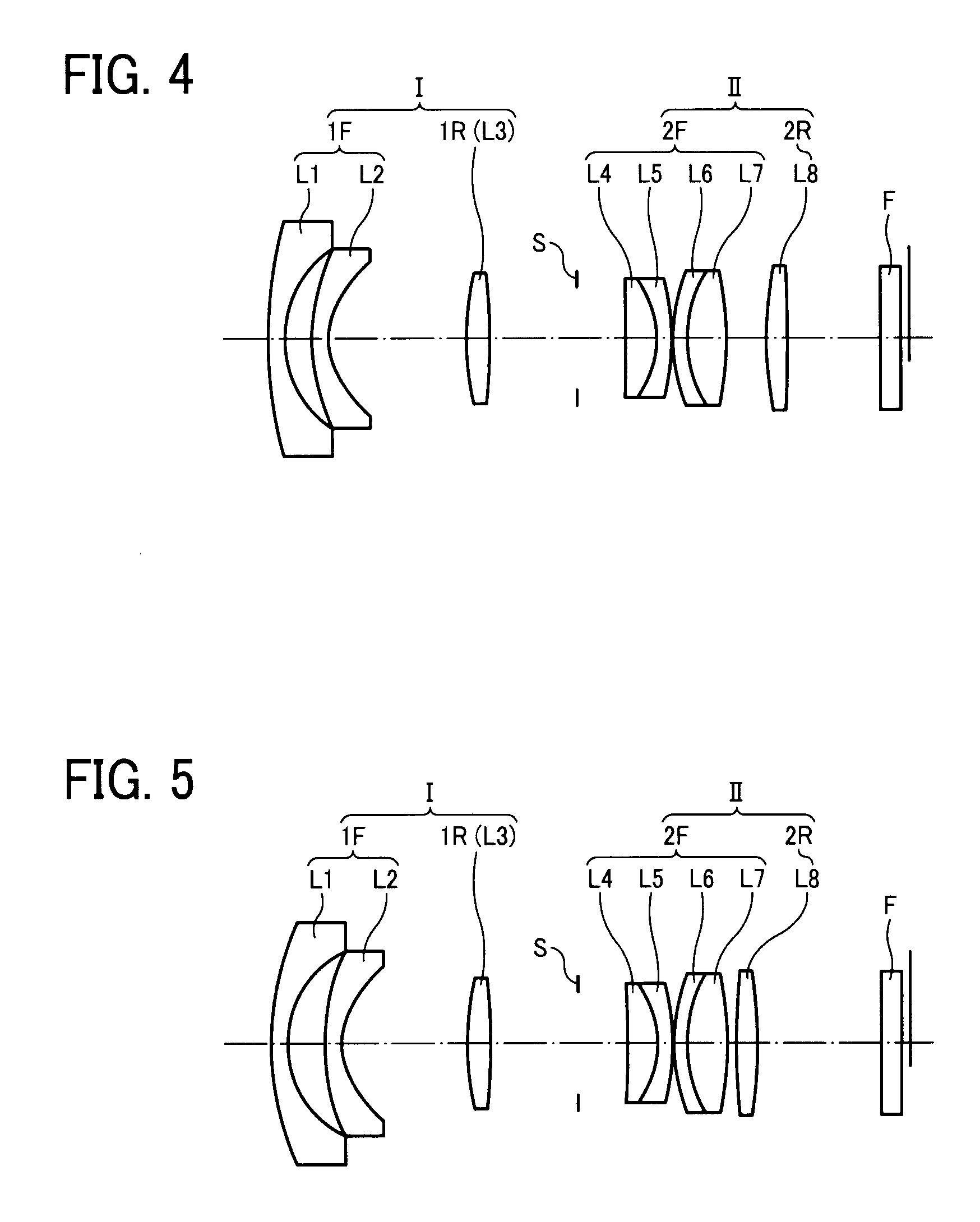Image forming lens, camera device, and handheld terminal
a technology of image forming lens and handheld terminal, which is applied in the field of lenses, camera devices, and handheld terminals, can solve the problems of chromatic aberration of magnification, distortion aberration, and inability to fully open the aperture stop, and achieve the effect of small siz
- Summary
- Abstract
- Description
- Claims
- Application Information
AI Technical Summary
Benefits of technology
Problems solved by technology
Method used
Image
Examples
example 2
[0344]f=6.00 F1.80 ω=39.1
[0345]Data of Example 2 are shown in Table 3.
TABLE 3RDNνHglass 161.0511.201.4970081.548.0S-FPL51 (OHARA) 29.7541.336.4 316.3001.201.5163364.066.3L-BSL7 (OHARA) 4*4.9339.505.2 518.7121.771.8160046.624.4S-LAH59 (OHARA) 6−49.7806.074.2 7Aperture4.083.7Stop 8−42.5532.221.4970081.543.6S-FPL51 (OHARA) 9−6.6301.001.6989530.133.7S-TIM35 (OHARA)10−16.6910.203.91112.0971.001.7282528.464.4S-TIH10 (OHARA)129.3183.081.4970081.544.4S-FPL51 (OHARA)13−26.1483.874.614*16.4941.501.5163364.064.8L-BSL7 (OHARA)15132.1605.714.816∞1.501.5000064.004.8Filter, etc.17∞0.604.8
Aspheric Surface
[0346]The data for the aspheric surfaces are shown below.
Fourth Surface
[0347]K=−0.40, A4=−4.07064E-04, A6=−9.23532E-06, A8=−7.96701E-08, A10=−3.61167E-09, A12=−3.61500E-11, A14=2.19580E-14, A16=8.93836E-15, A18=−1.95337E-15
Fourteenth Surface
[0348]A4=−3.58070E-04, A6=5.60374E-07, A8=−1.61334E-07, A10=1.41953E-09
Parameter Values of Relationship
[0349]The parameter values of each relationship are shown...
example 3
[0350]f=6.00 F1.90 ω=39.1
Data of Example 3 are shown in Table 5.
TABLE 5RDNνHglass 129.2701.201.4970081.548.5S-FPL51 (OHARA) 28.6861.936.6 316.3001.301.5163364.066.5L-BSL7 (OHARA) 4*4.99610.825.3 518.0931.741.8160046.624.4S-LAH59 (OHARA) 6−65.9586.334.2 7Aperture3.503.62Stop 8−117.2842.161.4970081.543.7S-FPL51 (OHARA) 9−7.2761.081.6989530.133.8S-TIM35 (OHARA)10−20.4370.203.951112.3801.001.7282528.464.4S-TIH10 (OHARA)129.0732.731.4970081.544.4S-FPL51 (OHARA)13−34.7163.414.514*17.2131.501.5163364.064.8L-BSL7 (OHARA)15198.6526.294.816∞1.501.5000064.004.8Filter, etc.17∞0.604.8
Aspheric Surface
[0351]The data for the aspheric surfaces are shown below.
Fourth Surface
[0352]K=−0.40, A4=−3.72757E-04, A6=−5.62333E-06, A8=−2.23363E-07, A10=−7.20448E-10, A12=−3.61500E-11, A14=2.19580E-14, A16=8.93836E-15, A18=−1.95337E-15
Fourteenth Surface
[0353]A4=−3.07134E-04, A6=2.41618E-06, A8=−1.97489E-07, A10=2.81138E-09
Parameter Values of Relationship
[0354]The parameter values of each relationship are shown i...
example 4
[0355]f=6.00 F1.89 ω=39.1
[0356]Data of Example 4 are shown in Table 7.
TABLE 7RDNνHglass 129.5531.201.4970081.548.1S-FPL51 (OHARA) 27.7002.036.2 314.6571.201.5163364.066.1L-BSL7 (OHARA) 4*4.9699.795.2 518.6051.781.8040046.574.4S-LAH65 (OHARA) 6−45.7196.164.27Aperture3.503.6Stop 8300.0002.221.4970081.543.7S-FPL51 (OHARA) 9−7.2491.171.6989530.133.8S-TIM35 (OHARA)10−26.9030.203.91114.9411.001.6541239.684.3S-NBH5 (OHARA)129.5452.921.4970081.544.4S-FPL51 (OHARA)13−20.2742.804.614*19.0141.501.5163364.064.8L-BSL7 (OHARA)15−2135.5826.824.816∞1.501.5000064.004.8Filter, etc.17∞0.604.8
Aspheric Surface
[0357]The data for the aspheric surfaces are shown below.
Fourth Surface
[0358]K=−0.40000, A4=−4.08087E-04, A6=−9.12948E-06, A8=−1.55692E-07, A10=−3.07007E-09, A12=−3.61500E-11, A14=2.19580E-14, A16=8.93836E-15, A18=−1.95337E-15
Fourteenth Surface
[0359]A4=−2.75989E-04, A6=1.94315E-06, A8=−1.43531E-07, A10=1.93052E-09
Parameter Values of Relationship
[0360]The parameter values of each relationship are sh...
PUM
 Login to View More
Login to View More Abstract
Description
Claims
Application Information
 Login to View More
Login to View More - R&D
- Intellectual Property
- Life Sciences
- Materials
- Tech Scout
- Unparalleled Data Quality
- Higher Quality Content
- 60% Fewer Hallucinations
Browse by: Latest US Patents, China's latest patents, Technical Efficacy Thesaurus, Application Domain, Technology Topic, Popular Technical Reports.
© 2025 PatSnap. All rights reserved.Legal|Privacy policy|Modern Slavery Act Transparency Statement|Sitemap|About US| Contact US: help@patsnap.com



